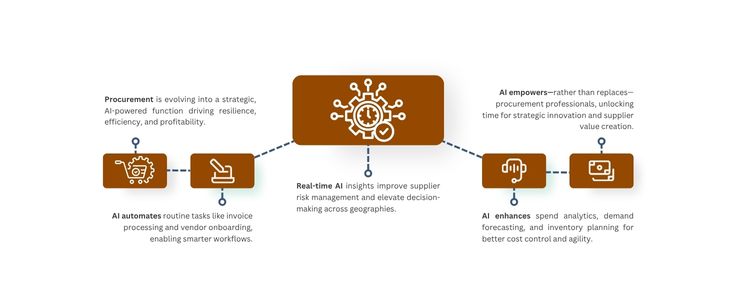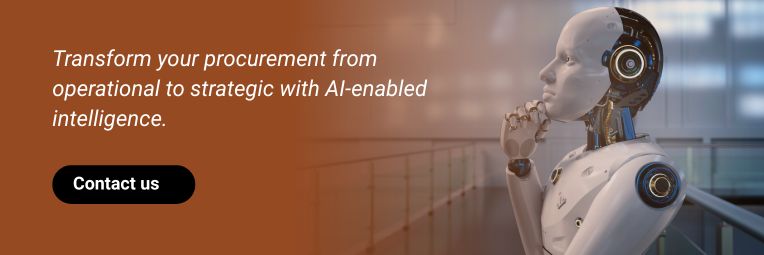AI in Procurement: How It Saves Time, Money, and Headaches
Introduction: Procurement Enters a New Era
In today’s business world—characterised by supply chain volatility, inflation persistence, and shifting ESG standards—procurement is experiencing a seismic shift from a support function to a driver of resilience and profitability. As the demand for speed, accuracy, and transparency increases, so too is the integration of AI in procurement not only justified but essential.
AI is automating boring tasks, allowing for more accurate forecasting, and facilitating smart decision-making. AI is enabling automation, accuracy, and intelligent decisions while eliminating manual efforts that procurement professionals have had to contend with forever. It’s creating time and cost savings, but more importantly, it’s eliminating the hassle—and time waste—of numerous supply chains, as well as data overload.
1. Streamlining Routine Processes with Intelligence
A significant number of procurement workflows—e.g., invoice processing, RFQ comparisons, and vendor onboarding—are repetitive in nature. AI tools can now at a high level of accuracy and consistency do each of these tasks, making a mistake less likely than when these activities were handled manually.
For example, natural language processing algorithms can read and categorise supplier documents in seconds; robotic process automation allows orders, approvals and payments to flow through the system without human intervention. This reduces manual errors, and allows procurement teams to spend less time on transactional and operational tasks and more time on strategic objectives.
Using intelligent automation is a desirable goal in a modern Procurement Transformation Service, recognising that this notion is about transforming the entire procurement lifecycle (including the redesign of process) and not simply applying technology.

2. Enhanced Supplier Management and Risk Mitigation
Supplier performance management has historically been a reactive function. However, with AI monitoring supplier activity in real-time, businesses can respond to delays, quality issues, or compliance problems proactively, before they escalate.
More advanced applications of supplier performance management use public domain data, news accounts, and ESG scores to deliver supplier risk warnings in a proactive manner, giving businesses the opportunity to react rapidly — change suppliers, change schedules, negotiate new terms, etc. — to minimize disruption before it creates a serious interruption.
Forward-thinking global sourcing companies are already incorporating AI into their risk assessment architecture, allowing companies to stay agile in their supply chains even when global disruption occurs.
3. Smarter Spend Analytics and Cost Reduction
One of the most visible benefits of AI in procurement is the ability to analyze historic spend data and identify opportunities for cost savings. AI platforms can identify price discrepancies between geographical areas, identify maverick spend, and provide more economical procurement alternatives.
Additionally, AI can help with dynamic price modelling based on commodity pricing, currency movements and freight costs—making it easier for procurement leaders to buy more intelligently and negotiate.
For many companies, and especially anecdotal in those who are supported and partner with India, this intelligence can be leveraged to create immediate cost savings without impacting quality and timelines
4. Predictive Demand Planning and Inventory Control
Typically, demand planning is a combination of historical patterns, salesperson reporting, and guesswork. However, AI-driven forecasting engines leverage many multi-variable inputs—everything from market signals, promotions calendar, regional buying behavior, and more—to create accurate demand models.
This helps reduce overstock as well as avoids stock-outs—two of the most notorious procurement pain points. AI has even given us a better approach to recommending optimal reorder points and batch sizes, making inventory planning smarter and leaner! When demand planning capabilities are included in Procurement Transformation Services, it enables organizations to juggle the competing pressures of working capital and the need for customer service—particularly in fast-moving industries like grocery, electronics, and FMCG.
5. Elevating Decision-Making with Real-Time Insights
Procurement professionals find themselves overwhelmed with data in different categories, agencies and geographies. AI helps filter, identify, retrieve and display that data in intuitive dashboards that promote faster and more informed strategic decision-making. For Indian sourcing companies, who look after international clients with complex specifications and delivery expectations, AI is a godsend: the sourcing company can make quick decisions on the ground when they know they are contributing to global procurement decisions.
If it comes to selecting a vendor on the basis of multi-criteria scoring, or predicting the impact of a change in regulation, AI can offer actionable intelligence at every stage of the procurement process.
Conclusion: AI as an Enabler, Not a Replacement
The increasing prevalence of AI in the procurement process is not about replacing procurement professionals; it’s about equipping procurement professionals. By automating tedious tasks and informing high-level strategic decisions, AI provides teams the opportunity to focus on managing supplier relationships, exploring next-generation sourcing strategies and connecting procurement teams to the business as it continues to grow.
It’s an exciting time for procurement in India, particularly with its digital ecosystem and evolving sourcing and procurement infrastructure that can drive AI-enabled procurement forward. Companies that are looking to partner with a procurement partner in India, should evaluate not only domain expertise, but also their existing capabilities related to the deployment of AI-enabled tools.









